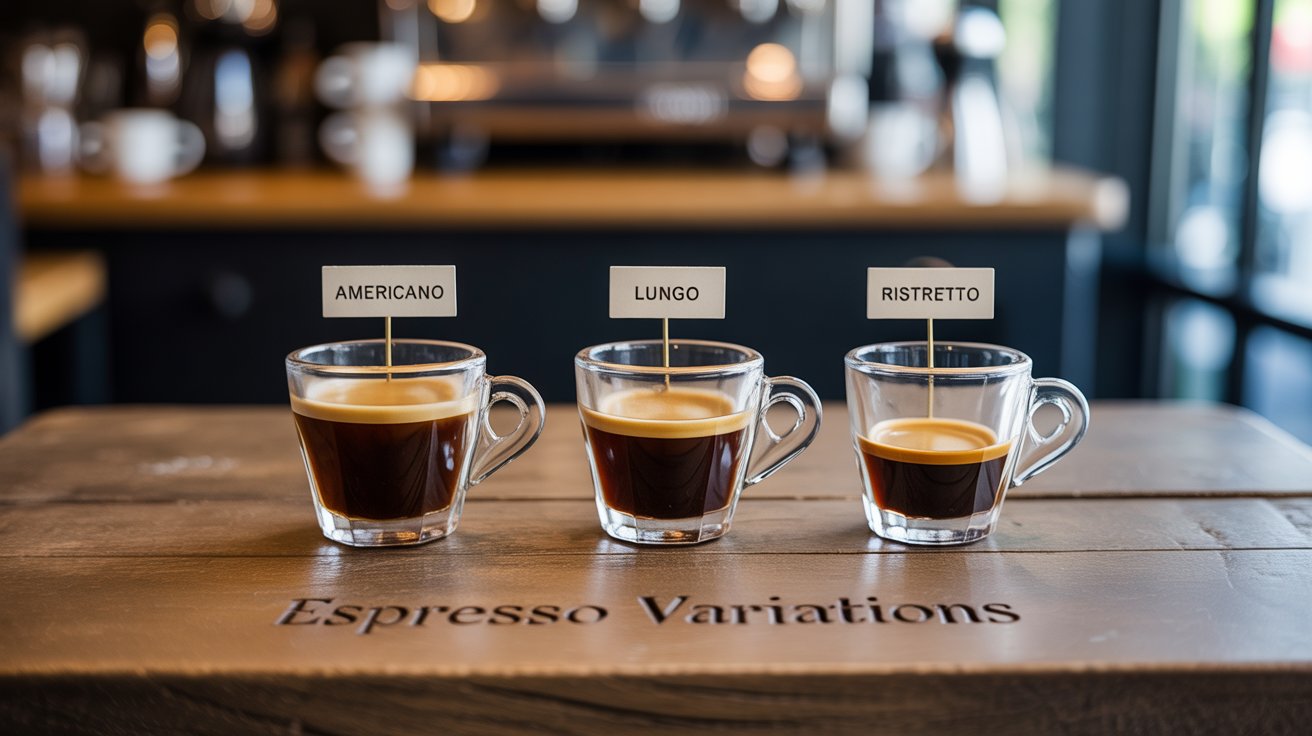Ever wondered why one espresso shot can taste smooth and mellow, while another feels bold, bitter, or almost syrupy? That’s where espresso variations: Americano, Lungo, Ristretto come in.
Most coffee drinkers don’t realize that a tiny change in water ratio or brew time completely transforms flavor, caffeine kick, and mouthfeel. Order wrong, and you’ll either end up with a watered-down cup or an over-intense shot you can’t finish.
The good news? Once you know the differences, you’ll never second-guess your order again. In this guide, I’ll break down Americano, Lungo, and Ristretto—what sets them apart, how they taste, and which one matches your style—so you can sip like a barista pro.
What Are Espresso Variations?
At its core, espresso is simple: a small, concentrated shot of coffee made by forcing hot water through finely ground beans under high pressure. But here’s the twist—change just the brew time or water ratio, and you don’t just get a slightly different taste… you get a whole new drink.
That’s why variations like the Americano, Lungo, and Ristretto exist. Each takes the same foundation—an espresso shot—but tweaks the preparation. The result? Three radically different experiences from the same coffee machine. One’s long and smooth, another’s bitter and complex, and the last is short, syrupy, and intense.
Think of it this way: one shot of espresso, three very different coffee experiences.
Coffee historians trace the Americano back to World War II, when American soldiers in Italy diluted espresso with hot water to mimic the drip coffee they missed back home. The Lungo (“long” in Italian) stretches the shot by running water through the grounds for a longer extraction, a technique still popular in European cafés. The Ristretto (“restricted”) cuts the shot short, concentrating flavors into a bold, sweeter hit prized by Italian baristas and specialty cafés like Illy and Lavazza.
These aren’t just brewing quirks. They’re cultural markers—how people in Rome, New York, or Melbourne think coffee should taste.
Americano vs Lungo vs Ristretto — Key Differences at a Glance
When you’re in line at Starbucks, Pret, or your local specialty café, you don’t want a lecture on coffee science—you want quick clarity. This table gives you that.
| Variation | Brew Ratio (Espresso:Water) | Extraction Time | Flavor Profile | Caffeine Level | Serving Size |
|---|---|---|---|---|---|
| Americano | 1:2 (espresso + added hot water) | Standard shot + dilution | Smooth, mild, closer to drip coffee | Moderate (diluted strength) | 6–12 oz |
| Lungo | ~1:4 (more water pushed through grounds) | 35–45 sec | Bitter, complex, less body | Slightly higher (longer extraction) | 2–4 oz |
| Ristretto | ~1:1 (short shot, less water) | 15–20 sec | Intense, sweet, syrupy | Slightly lower (shorter extraction) | 0.5–1 oz |
Pro tip: Don’t confuse caffeine intensity with caffeine content. A ristretto tastes stronger but often carries less caffeine than a lungo, because the extraction is shorter.
What Is an Americano?
An Americano is the simplest of the three variations. It’s an espresso shot diluted with hot water, creating a drink that looks and feels closer to drip coffee.
How It’s Made (Step-by-Step)
Pull a standard single or double espresso.
Add hot water—usually in a 1:1 or 1:2 ratio.
Stir gently and serve.
Flavor Profile
Smooth, light, and less intense than straight espresso. The added water opens up aromas while toning down bitterness.
Best For…
People who enjoy the convenience of café coffee but prefer something easier to sip than a concentrated shot. Ideal for mornings when you want volume without overload.
What Is a Lungo?
The Lungo (Italian for “long”) pushes espresso extraction further. Instead of adding water after brewing—like with an Americano—you let more water flow through the grounds during the shot itself.
Brew Process & Ratio
A lungo uses about double the water of a ristretto, with extraction lasting 35–45 seconds (vs. ~25 seconds for standard espresso). The result is a larger volume in the cup—typically 2–4 oz.
Flavor Notes
Expect a more bitter and complex taste. Because the longer pull extracts compounds like tannins and caffeine that don’t appear in shorter shots, lungos can feel sharper and drier. According to barista trainers at the Specialty Coffee Association (SCA), this bitterness is intentional—it’s part of the lungo’s character.
Who It’s Suited For
Drinkers who enjoy bold, lingering flavors over sweet notes.
Coffee enthusiasts looking for a higher caffeine hit without the dilution of an Americano.
Europeans who grew up with lungo-style espresso as the café standard.
What Is a Ristretto?
The Ristretto is the opposite of the lungo—a “restricted” or shortened shot designed for maximum flavor concentration.
Brewing Style
A ristretto uses the same amount of coffee grounds but half the water. Extraction time is shorter, usually 15–20 seconds, producing a dense shot of 0.5–1 oz. Some Italian cafés even treat ristretto as the “true espresso.”
Taste & Body
Syrupy, sweet, and intense. Because fewer bitter compounds are extracted, the ristretto often feels smoother despite its punch. Many tasters describe it as having a chocolate-like richness.
Best For Strong-Flavor Lovers
Perfect if you want espresso’s full impact in a concentrated sip.
Great for specialty beans where you want to highlight sweetness and unique origins (e.g., Ethiopian or Colombian single-origin).
Often ordered by experienced espresso drinkers who appreciate nuance over volume.
Side-by-Side Comparison: Americano, Lungo, and Ristretto
If you’re standing at the counter debating your order, you don’t need coffee theory—you need a clear comparison. This chart breaks down the essentials so you can decide in seconds.
| Variation | Brewing Time & Water Ratio | Taste Intensity | Caffeine Level | Serving Size | Popular Use Cases |
|---|---|---|---|---|---|
| Americano | Espresso (25–30 sec) + hot water (1:1 to 1:2 ratio) | Smooth, diluted, closer to drip coffee | Moderate (diluted strength, not less caffeine) | 6–12 oz | Great for slow sipping, office mornings, or replacing brewed coffee |
| Lungo | Long pull: 35–45 sec, ~1:4 ratio | Bitter, dry, more complex | Slightly higher (longer extraction) | 2–4 oz | Suited for European-style café drinks or those wanting intensity without extra shots |
| Ristretto | Short pull: 15–20 sec, ~1:1 ratio | Bold, sweet, syrupy, concentrated | Slightly lower (shorter extraction) | 0.5–1 oz | Perfect for a quick flavor punch, highlighting single-origin beans, or experienced espresso lovers |
Pro tip: Many cafés, from Starbucks to Lavazza bars in Rome, serve all three if you know how to ask. The trick is matching the drink to your moment.
Choosing the Right Espresso Variation for You
Your choice isn’t about right or wrong. It’s about matching taste, caffeine, and occasion. Here’s how to decide.
Based on Taste Preference
Smooth & light: Go Americano. It feels familiar if you’re used to drip coffee or pour-over.
Bitter & complex: Go Lungo. Expect more bite and dryness—an acquired taste, but deeply satisfying once you love it.
Bold & sweet: Go Ristretto. It’s concentrated enough to taste chocolate or caramel notes in high-quality beans.
Based on Caffeine Needs
Moderate boost: Americano works—volume without an overload.
Higher kick: Lungo extracts more caffeine thanks to its longer pull.
Fast jolt: Ristretto delivers intensity quickly, though the total caffeine is slightly lower.
Based on Occasion
Morning ritual at home: Americano or Lungo, depending on how long you want to sip.
Quick café stop in Italy or Melbourne: Ristretto—it’s the espresso insider’s choice.
Workday productivity fuel: Americano keeps your mug full without overloading your system.
Afternoon focus burst: Lungo brings bitterness and energy for long sessions.
Expert Tips to Brew Each Variation at Home
You don’t need a café barista license to pull a great Americano, Lungo, or Ristretto at home. What you do need: the right grind, correct timing, and a setup that fits your gear.
Proper Grind Size for Each
Americano: Start with a standard espresso grind. The water is added after brewing, so grind size doesn’t change—medium-fine works best.
Lungo: Go a touch coarser than espresso. Too fine, and the longer extraction turns harsh and over-bitter.
Ristretto: Go slightly finer. This helps pack flavor into the shorter shot while keeping sweetness intact.
Rule of thumb: Adjust your grind like you adjust salt in cooking. Small tweaks make a big difference.
Brewing Time Hacks
Americano: Pull your espresso (25–30 sec), then add hot water separately. Pro tip: pour water first, then espresso (“Long Black” style in Australia) to preserve crema.
Lungo: Extend extraction to 35–45 sec. Stop before the stream turns pale and watery—that’s when bitterness dominates.
Ristretto: Cut the shot short at 15–20 sec. Watch for a thicker, darker stream; that’s your flavor jackpot.
Espresso Machine vs Nespresso Pods vs Moka Pot
Espresso Machine (Breville, De’Longhi, Rancilio Silvia): Best for full control over grind, pressure, and timing. Ideal for ristretto precision.
Nespresso Pods: Simple and consistent. Many machines (like Nespresso Essenza Mini) offer “Lungo” buttons, but for true ristretto, pick capsules labeled “Ristretto.”
Moka Pot: Not true espresso (less pressure), but you can mimic Americano and Lungo. For a ristretto-style cup, pull the pot off the stove early before over-extraction.
Common Mistakes & Myths
Even seasoned coffee drinkers trip up here. Let’s bust the big ones.
Myth: Lungo Always Has More Caffeine Than Americano
Not exactly. A lungo extracts more caffeine because of the longer pull—but an Americano often uses a double shot of espresso before dilution. Net result? They can be equal, depending on how your barista makes it.
Mistake: Using Drip Coffee Beans Instead of Espresso Beans
Espresso needs beans roasted and ground for pressure brewing. Using medium-roast drip beans usually leads to sour, under-extracted shots. Look for beans labeled “Espresso Roast” from trusted roasters like Lavazza, Illy, or Stumptown Coffee Roasters.
Myth: Americano = Weak Coffee
A classic misconception. An Americano may taste lighter, but caffeine content can match or exceed a lungo. The smoothness comes from dilution, not lack of power. In fact, many U.S. coffee drinkers prefer Americano because it balances strength with sip-ability.
FAQs
Is a lungo stronger than an Americano?
Not in the way most people think. A lungo tastes stronger because of its bitterness and longer extraction. An Americano tastes lighter since it’s diluted with hot water. But in terms of caffeine, they can be similar depending on whether your Americano uses a single or double shot.
Which has more caffeine: ristretto or lungo?
A lungo usually contains more caffeine because it extracts longer. A ristretto tastes more intense but often has slightly less caffeine. Think: strength on the tongue vs. actual caffeine in your system.
Can you make a ristretto with a Nespresso machine?
Yes. Machines like the Nespresso Essenza Mini or VertuoLine let you program shot volume. Choose a capsule labeled “Ristretto,” shorten the pour to about 15–20 seconds, and you’ll get close to the real thing.
Which is closest to black coffee?
The Americano. Its diluted espresso base gives you volume and smoothness that feels similar to drip coffee, making it the go-to for U.S. coffee drinkers who want familiarity without losing espresso’s depth.
Final Thoughts
Three drinks. One base. Completely different experiences.
Americano: smooth and diluted—your espresso made sip-able.
Lungo: long and bitter—complexity for those who love intensity.
Ristretto: short and sweet—espresso at its most concentrated.
The best part? You don’t need to pick a “winner.” Coffee is personal. The only way to know your favorite is to brew, taste, and compare. Try all three—at a café, with your Nespresso machine, or on your own espresso setup—and discover which variation fuels your mornings best.

Shahriar brings a unique blend of storytelling prowess and digital expertise to Daily Coffee Guide. With a background in SEO and content strategy, he ensures our articles on Beans, Coffee, Tea, and Drinks are both engaging and discoverable. His passion for coffee culture drives him to explore and share the rich narratives behind every cup.

